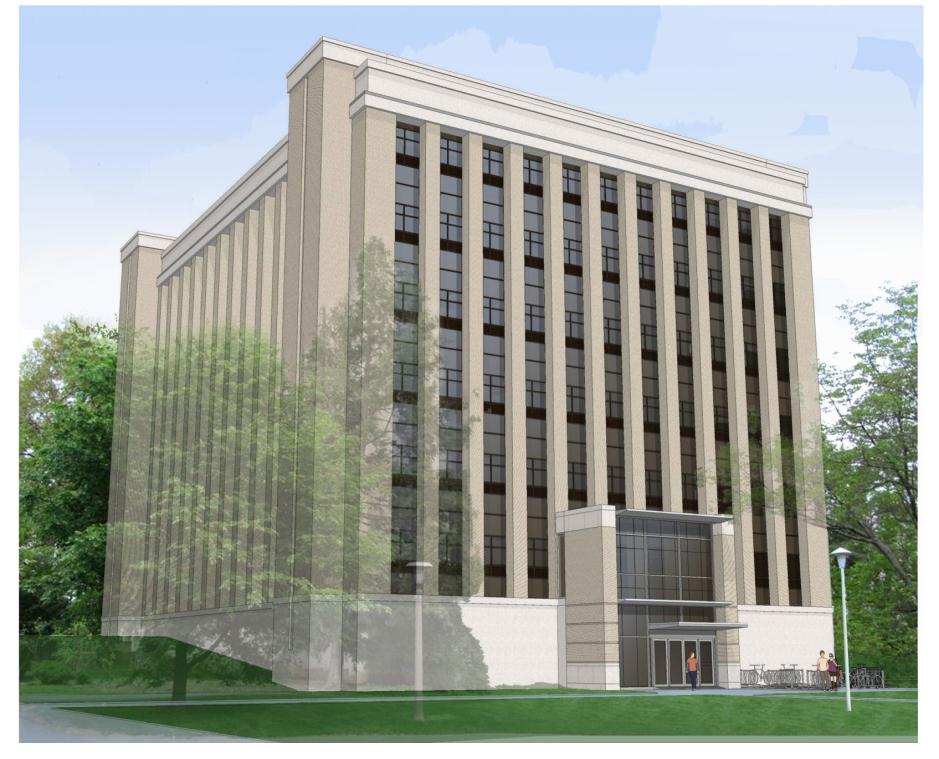Thesis Proposal:
Depth Topics:
Recycling Opportunities
The Mueller building renovation includes the full gutting of four of the building's seven floors. A large portion of the demolished materials will include ductwork and HVAC piping. This large quantity of similar construction debris makes the project a prime candidate for a large scale recycling effort. The possibility of recycling both on site and off site will be discussed. Furthermore, as the project moves from demolition to construction, transitioning methods of recycling will be examined. Associated costs with these methods can also be investigated.
Asbestos Abatement
This project also includes abatement of asbestos on the floors being renovated. This abatement takes up a not insignificant part of the schedule. Alternated methods of abatement will be looked at, as well as the legal requirements. Saving schedule time by increasing manpower for abatement, or by canceling the abatement all together, are both possibilities. Each option has its own ramifications on the project cost.
Roof Reinforcement
Roof reinforcement is necessary for new air handling units (AHUs) to be installed. Currently the reinforcement is planned to be installed under the roof deck. If the reinforcing is instead placed on top of the roof deck the installation process will be greatly simplified, saving time and eliminating difficult overhead work. Details of attaching of the reinforcing to the top of the roof deck will be examined as a CM depth study.
Site Logistics
Site logistics are another issue of the project. Located on the busy PSU campus requires a small job site, as well as disturbance to pedestrian traffic in the area. Alternate material storage and contractor parking locations are discussed. Use of space south of the project could open possibilities for a safer, cleaner job site. A more general study of different site possibilities is necessary. This study will either confirm that the campus is being minimally disturbed, or will show ways to lessen the disturbance to the campus.
Breadth Topics:
Structural Breadth:
To reinforce the roof for the new air handler units, 25 steel beams are to be installed underneath the existing concrete beam structure supporting the roof deck. These beams range from W12X26 to W12X65. This task requires the ceiling plenum of the 6th floor to be demolished so the beams can be lifted into place and secured. Installation of these reinforcing beams is on the schedule critical path, since the air handler units can't be placed until the reinforcing is in place. Furthermore, installation is time consuming due to the constraints of working overhead in confined spaces.
As a structural analysis breadth topic, relocation of the reinforcing from underneath the roof deck to on top of the roof deck will be examined. Placing this reinforcing on top of the roof deck should have no effect on the structural strength of the roof. Rooftop placement simplifies installation and is not dependent on the demolition of the 6th floor ceiling plenum. Details regarding affixing the reinforcing to the roof deck will be examined as a CM depth topic.
Specific deliverables will include:
1. A complete description of the both building's existing roof framing and the increased roof load due to the new air handler units being installed. Calculations showing the necessity of roof reinforcement will be given.
2. A complete description, with drawings, of the renovation's current design for under-deck roof reinforcement plan.
3. A complete description, with drawings and corresponding calculations, of my proposed roof-top roof deck reinforcement plan.
4. A comparison of the existing reinforcement plan and my reinforcement plan, and a recommendation of which plan is best, based on cost and duration.
Electrical Breadth:
Fluorescent fixtures are being replaced with LED fixtures throughout the renovation. Replacing 2x4 recessed fluorescent troffers with 2x4 recessed LED troffers has a short payback period due to their high efficiency. LED downlights also are very efficient. However, improvements in LED technology can quickly make current LED fixtures obsolete. Because of this, LED fixtures that can be easily and cheaply upgraded are desirable.
For electrical breadth the recessed LED downlight fixtures will be compared to standard incandescent recessed downlight fixtures with Edison-type sockets that are equipped screw-in LED bulbs. Screw-in LED bulbs are currently available with lumen output, CRI, and color temperature very similar to the project's specified recessed LED downlight fixtures. However, these screw-in LED bulbs are far cheaper. Also, a screw-in LED bulb can be easily replaced in the future with an LED bulb that has a higher CRI, or is more efficient, or has a higher lumen output. Thus, using a screw-in LED bulb satisfies the lighting performance specifications, costs less, and allows for easy future upgrades.
Specific deliverables will include data to showing that Edison-type socket fixtures with screw-in bulbs:
1. Offer the same performance as hard-wired LED can lights
2. Cost less than hard-wired LED can lights
3. Allow for easy future upgrades to even more energy efficient/better CRI LED bulbs.
Final Proposal Revision 2
Final Proposal Revision 1
Revised Spring Analysis Schedule
Final Proposal
Spring Analysis Schedule
Proposal Presentation
Proposal Presentation Report

